Basic Bread Machine White Bread You’ll Be Eager To Share
Sneak Peek: This basic Bread Machine White Bread is a soft, fluffy 1.5-lb loaf with no eggs and little sugar or fat. And yes, you can make this beautiful loaf with the help of your bread machine. Also, don’t miss the secret ingredient that helps make this the best bread machine white bread recipe.
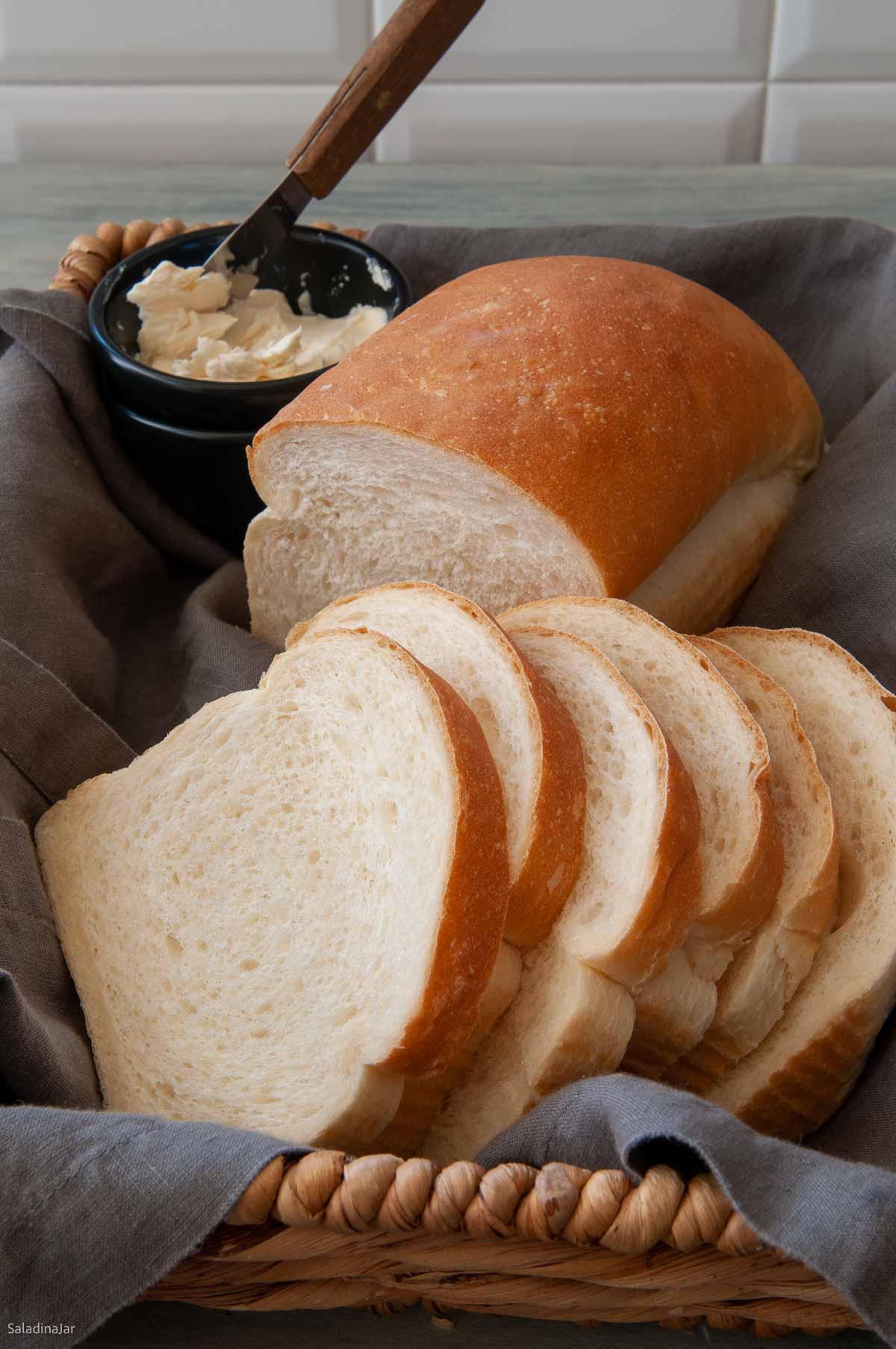
As an Amazon Associate, I earn from qualifying purchases.
Have you tried the first white bread recipe listed in the manual printed by your bread machine manufacturer? Did you make it from beginning to end with the one-and-done button? If you weren’t thrilled with the results, I have an alternative.
Three Reasons Why You Might NOT Want To Make Recipes From the Owner’s Manual
- Was the crust of your first loaf thick and hard?
- How did the top look? Was it nicely domed or misshapen and ugly?
- Was the crust browned or much lighter on top than the rest of the bread?
- How was the inside of your bread? Was the crumb organized or verging on crumbly? Was it light and fluffy on top but dense on the bottom?
The bread I described above is probably good enough for toast if you aren’t particular. But if you want a loaf you are excited to eat and proud to share with others, follow this recipe as closely as possible.
The directions are for a bread machine because it is the best kneading machine in town. But you can make it with a stand mixer or by hand. See the recipe notes for details.
Happy Bakers Speak Up
“I never review recipes but this one definitely deserves 5 stars. I’ve made bread in my machine several times but was never impressed.
This is by far the best bread I’ve ever made and it was easy. The texture, color and taste were perfect. Thanks so much for the recipe!” — ASHLEY
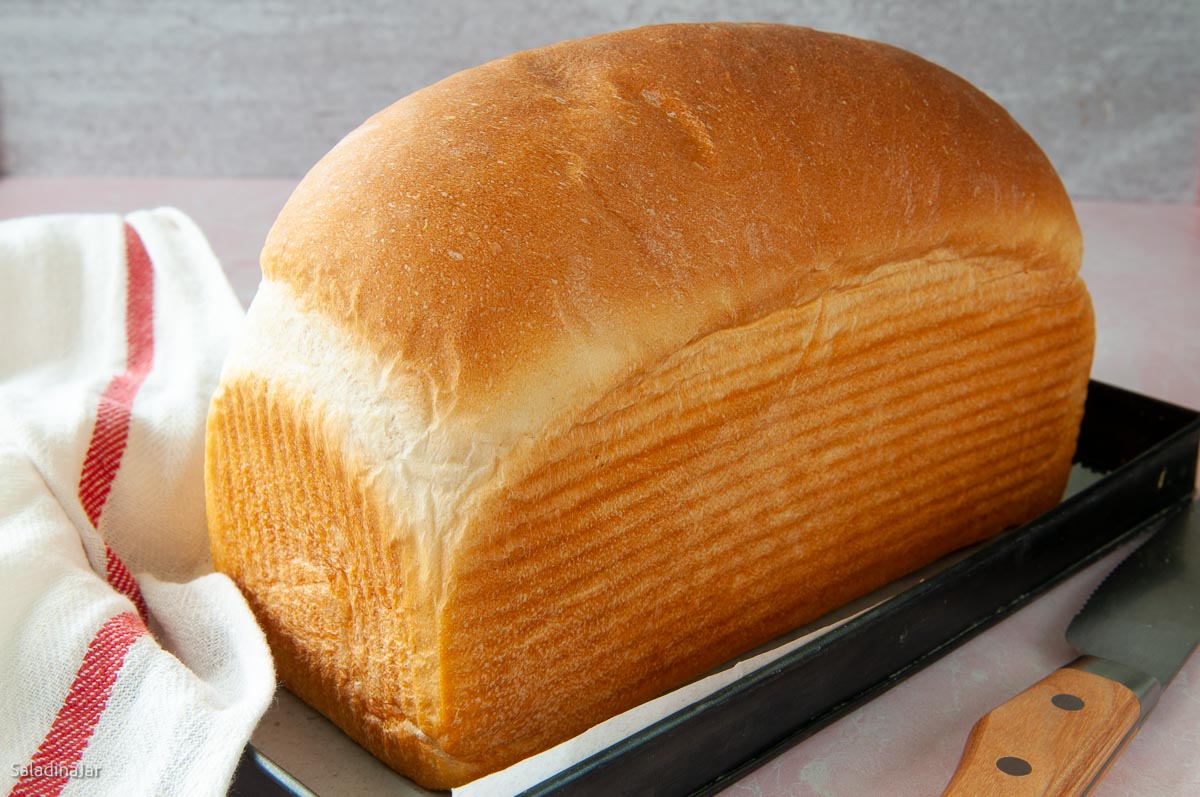
If you want your loaf to have perfectly straight up-and-down sides like the one pictured, use a 9x4x4-inch USA Pullman pan. Notice the beautifully golden brown and tender crust. You will never get this result by baking bread in a bread machine.
Recipe Inspiration
Are you open to a different way of using your bread machine other than start-to-finish with the push of one button? If so, I can show you how to use a bread maker to make fabulous bread.
A bread machine is one of the best kneaders in town. Plus, you get a timer with it. So you can throw the carefully measured ingredients into the bread machine, turn it on, and let it do the work while you start your next project.
You’ll want to open the lid and check the dough a time or two to ensure it’s not too dry or wet. Otherwise, you can leave it alone for an hour and a half (varies with different machines), and when you return, the dough should be ready to shape.
One of the secrets to producing fabulous bread with a bread machine is to use the DOUGH cycle only. That means you will let the machine mix and knead the dough (great for people who find it painful to manipulate it with your hands). Then, shape the dough with your hands, let it go through one more rise, and bake it in your conventional oven.
Does it sound like a lot of work? It may take a few extra minutes, depending on your experience. But it’s worth it.
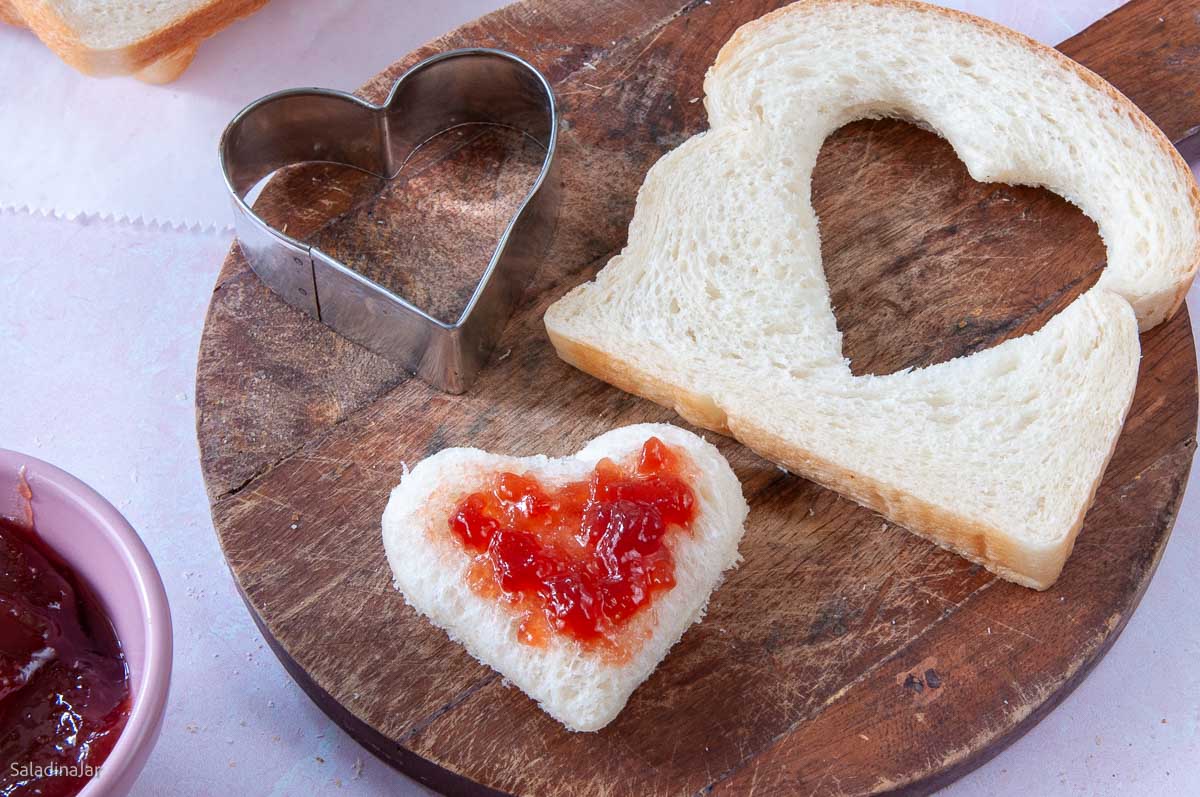
“Making great bread is not as easy as pushing one button on a bread machine, as many people hope. However, with a little extra attention and experience, you can use a bread machine to produce a loaf you will be proud to share and excited to eat.“–A Paula-ism
Ingredients and Substitutions
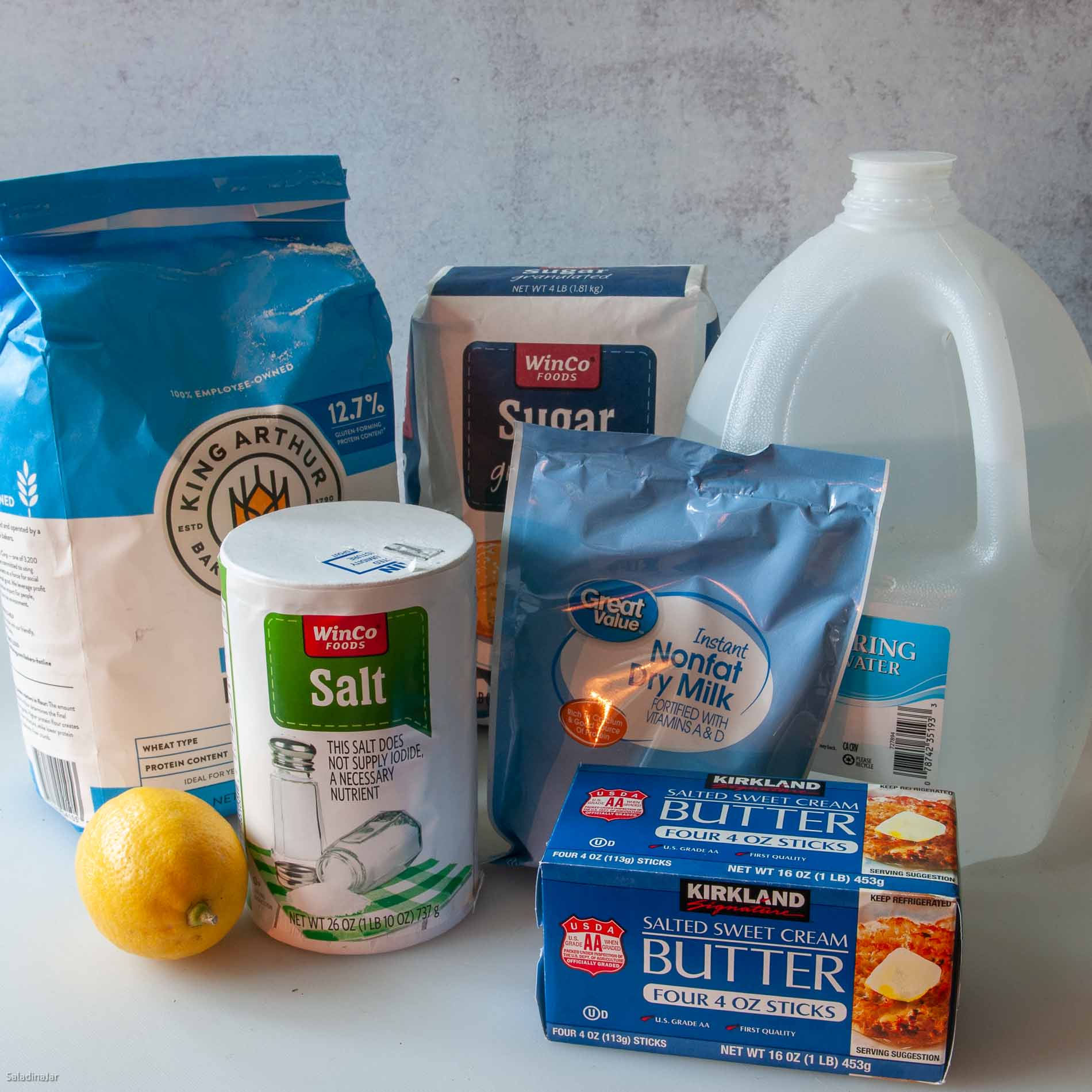
- WATER: If your water is especially hard or very soft, you may want to stick with spring water. I like to draw tap water and let it sit for 24 hours to let the chlorine dissipate. But there’s no reason to fuss about this unless you are having trouble. Use water straight out of the tap.
- SUGAR: I use a small amount of granulated white sugar, but you can also use honey or brown sugar as substitutes. I don’t recommend using sugar substitutes, as they’re not ideal for yeast.
- SALT: The recipe calls for table salt or sea salt. If you prefer Kosher salt, use a bit more, but don’t omit salt completely. Without salt, the bread will taste bland, and the yeast won’t function properly, potentially leading to a collapsed loaf. While you can try reducing the salt, this recipe isn’t intended for no-salt bread.
- NONFAT DRY MILK:
Powdered dry milk adds the benefits of fresh milk to this recipe. Since it contains no eggs or fresh milk, you can use a timer to start the DOUGH cycle later without the ingredients spoiling. When using a timer, ensure the milk powder doesn’t touch the water by mixing it with the flour first.- If you don’t have powdered milk, you can replace the water with fresh milk. However, remember to check the dough during mixing. Without powdered milk, it might need a bit more flour. Observe the dough while it kneads: it should stick to the sides of the pan initially and then pull away cleanly.
- BUTTER: I prefer real butter, but non-dairy butter or vegetable oil are good alternatives. You don’t need to bring the butter to room temperature; chop it finely and add it to the pan before the flour. The friction caused by the kneading paddle will heat the butter (and the dough) to the perfect temperature.
- LEMON JUICE: Lemon juice is the secret ingredient. It adds lightness and brightness to your bread. The amount is so small that you won’t taste it, but it makes a significant difference.
- Smell the bread once it has cooled; you’ll notice it has a fresher and more inviting aroma than store-bought bread. If you don’t have lemon juice, it’s fine to leave it out. Your bread will still turn out great.
- FLOUR: The recipe recommends bread flour due to its high protein content, which helps the bread rise and adds a slightly chewy texture. You can substitute unbleached all-purpose flour if necessary, but keep in mind that your bread might not rise as much.
- YEAST: Instant or bread machine yeast is ideal for bread machines and this recipe. You don’t need to dissolve the yeast unless you suspect it’s old. If all you have is active dry yeast, you can use that instead, though it may act a bit slower. Add an extra 1/4 teaspoon or give the dough more time to rise.
How To Make White Bread Dough with a Breadmaker
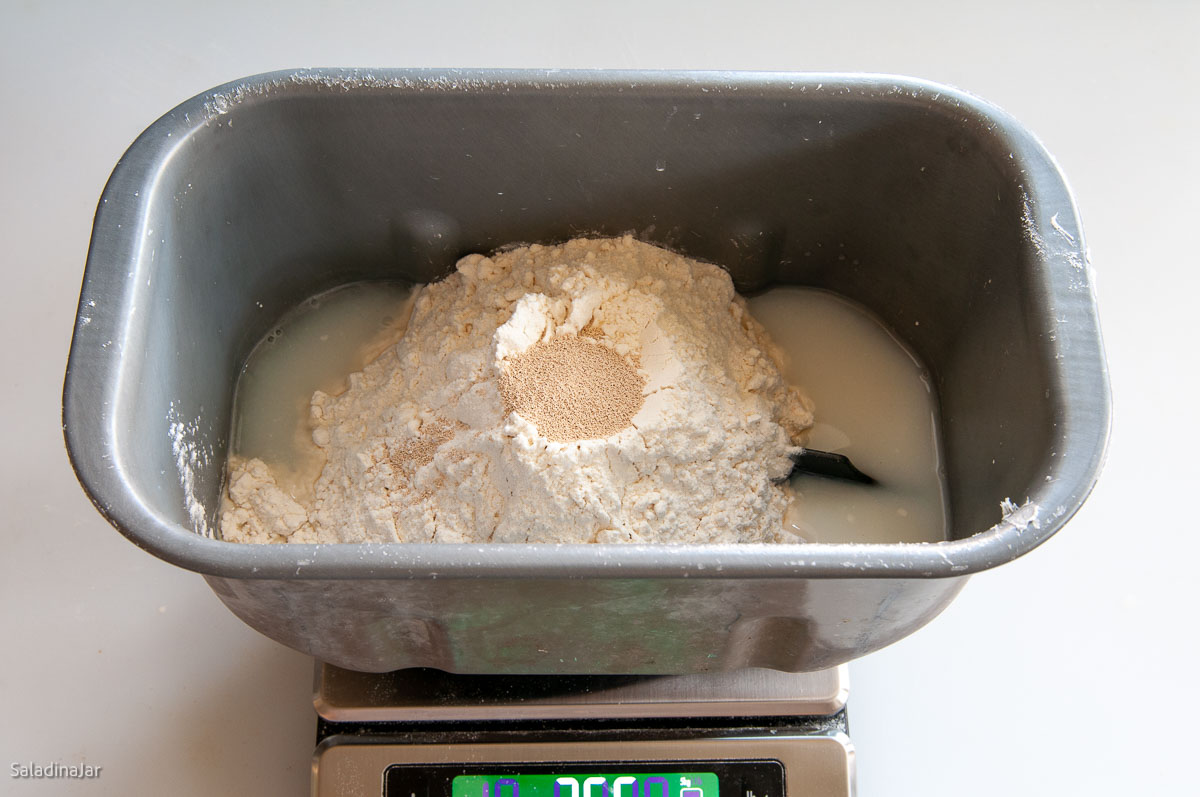
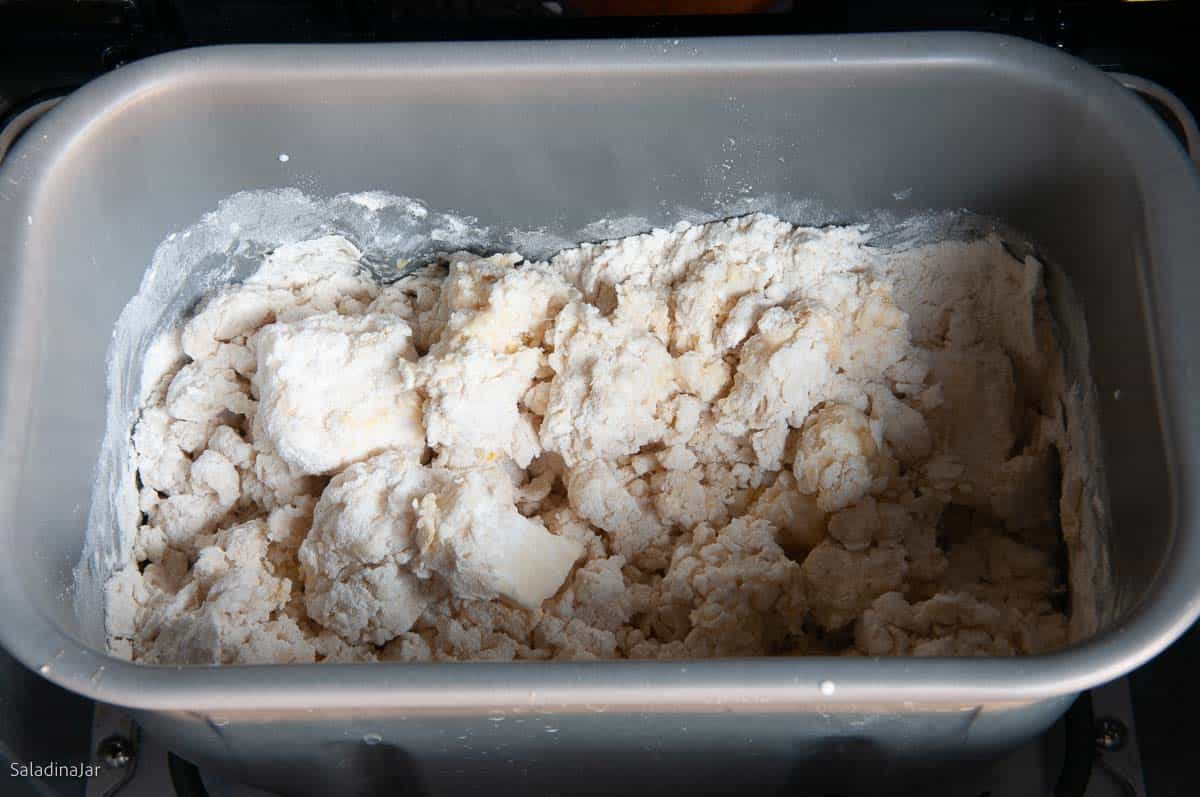
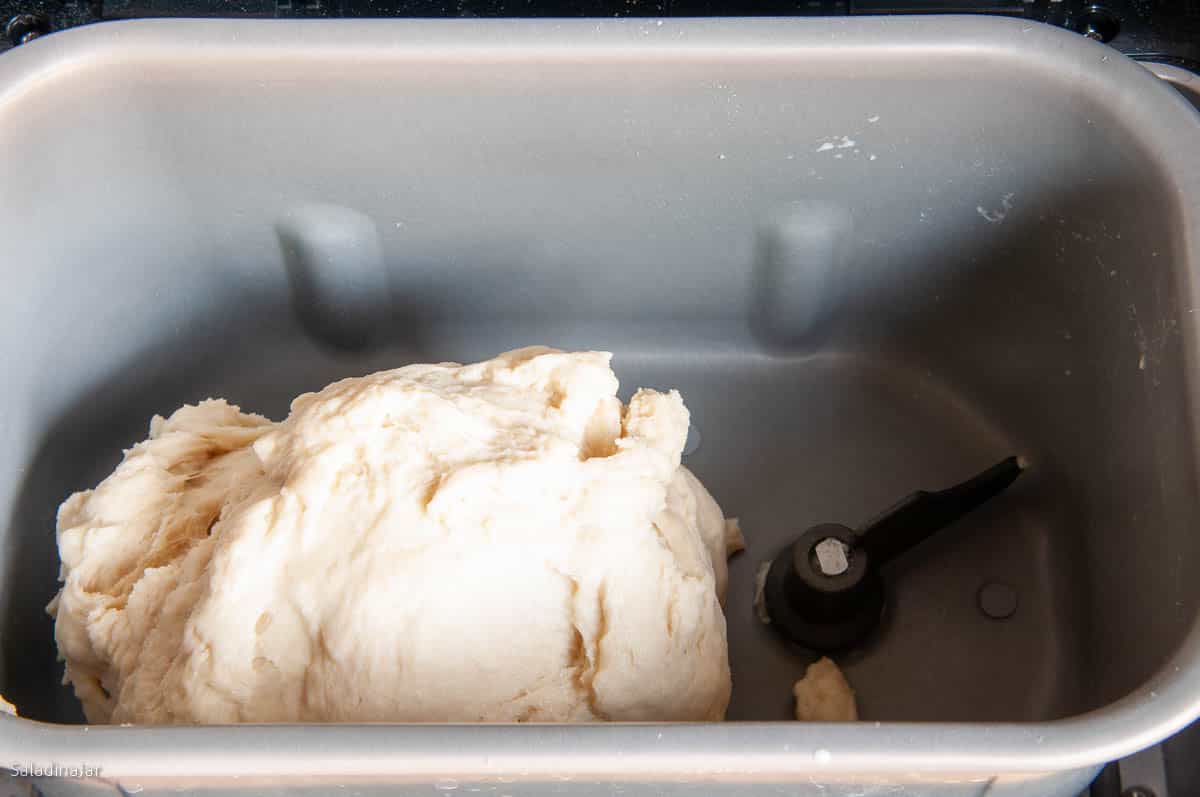
How to assess the dough in a bread machine and what to do next:
a) If the dough looks like a thick pancake batter (possible measuring error) or if there’s wet dough underneath the paddles, add a tablespoon of flour. Wait a minute or two for it to mix in while kneading. Repeat this process until the dough sticks to the side and pulls away cleanly.
b) If the dough is too dry and bounces off the wall or rides on top of the paddle like a merry-go-round, add a tablespoon of water. Give the machine a minute to mix it in. You might need to use a spatula to help incorporate the water into the dough.
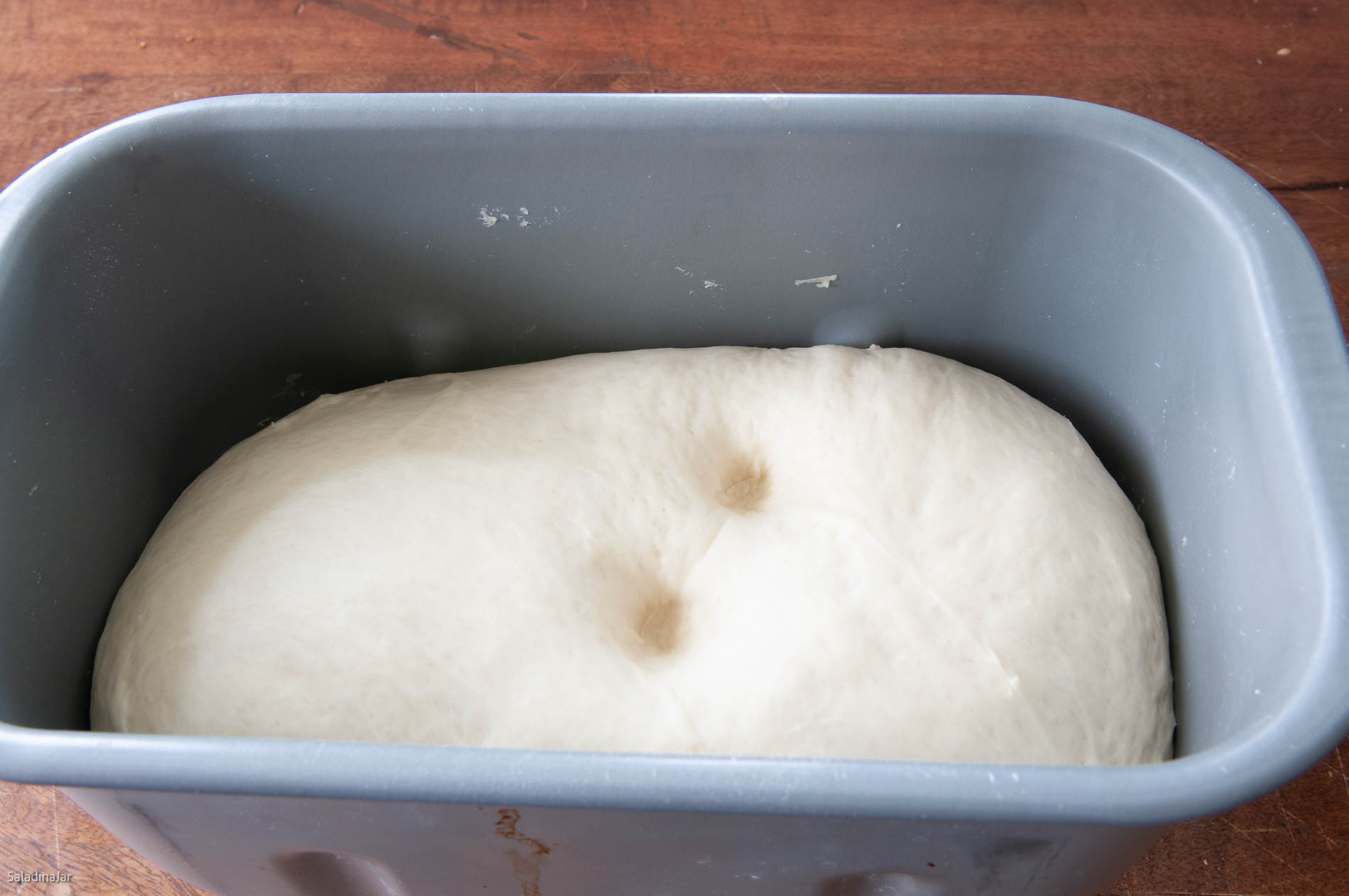
If the dough doesn’t rise in an hour, it’s likely due to missing yeast, inactive yeast, or a low ambient temperature. When yeast is cold, it is in no mood to eat and belch carbon dioxide, causing the dough to rise.
At the end of the DOUGH cycle, check if the dough has doubled using the two-finger test: gently press two flour-covered fingers into the dough. If the holes slowly close but not entirely, the dough is ready. If it springs back, wait until it leaves a temporary impression. When ready, remove the dough from the pan and shape it as shown below.
Shaping the Dough
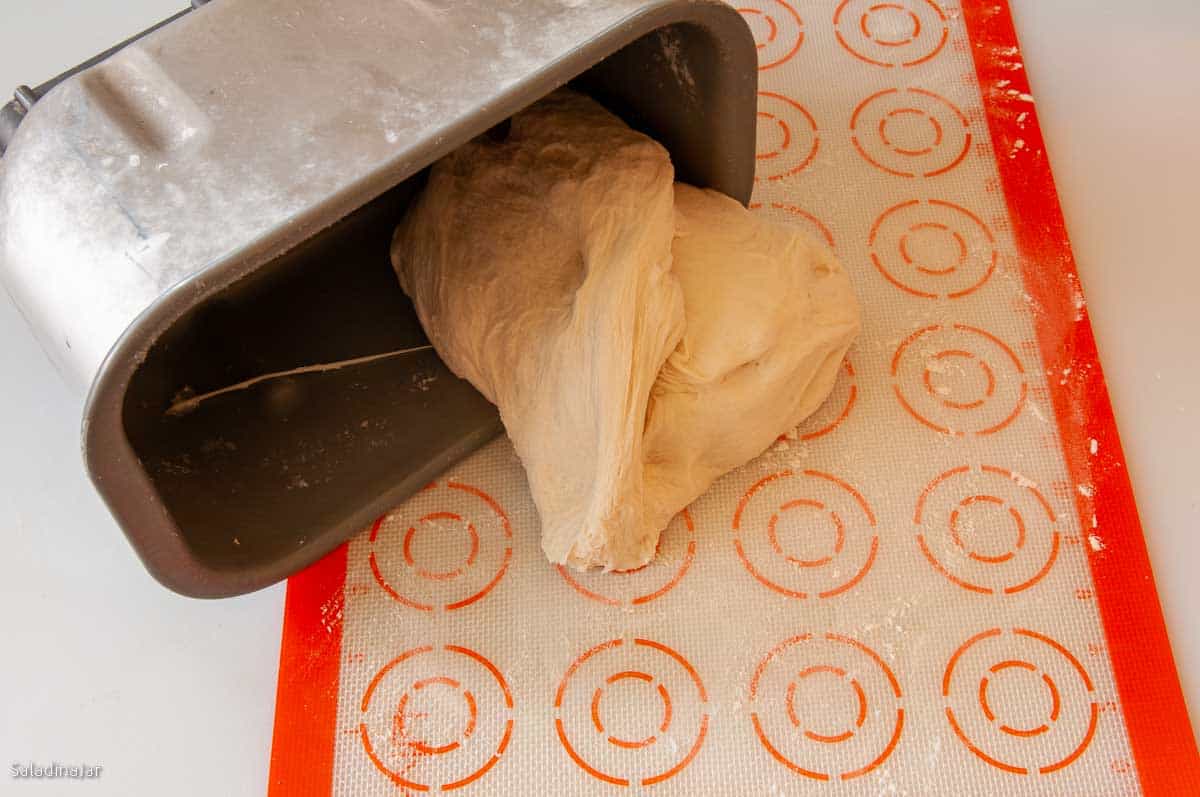
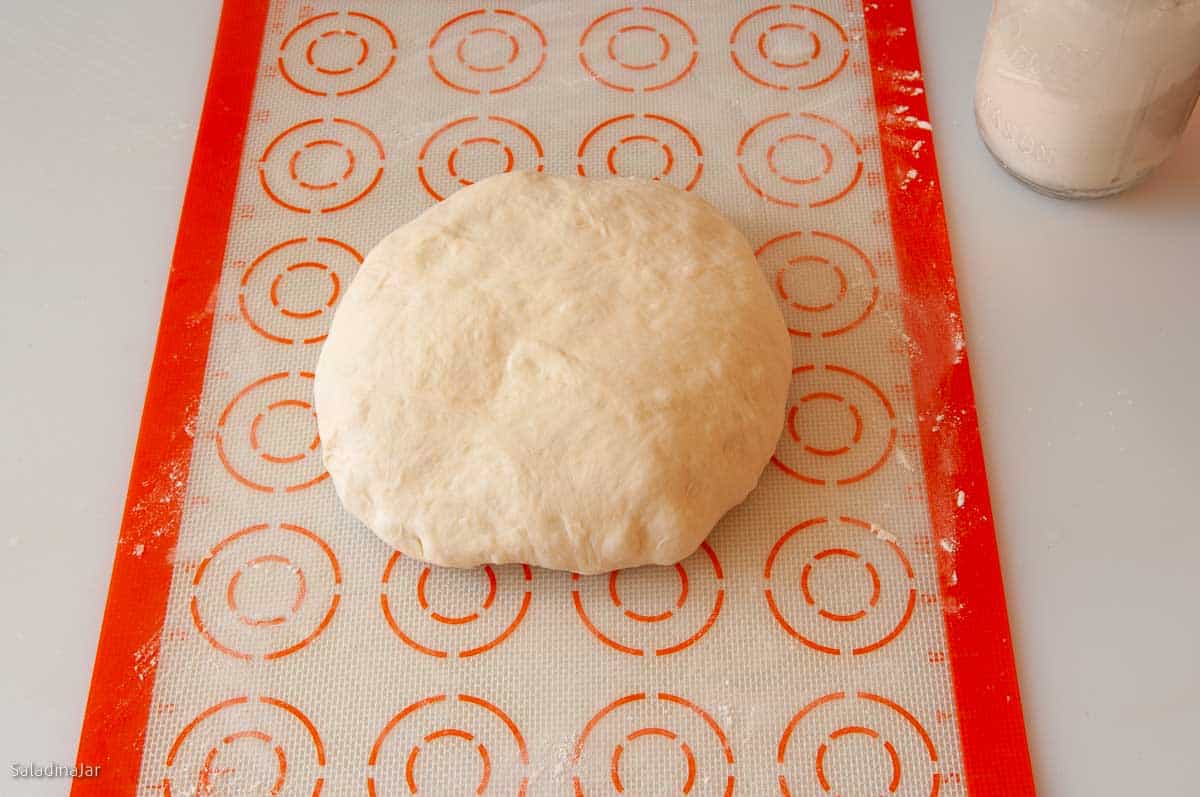
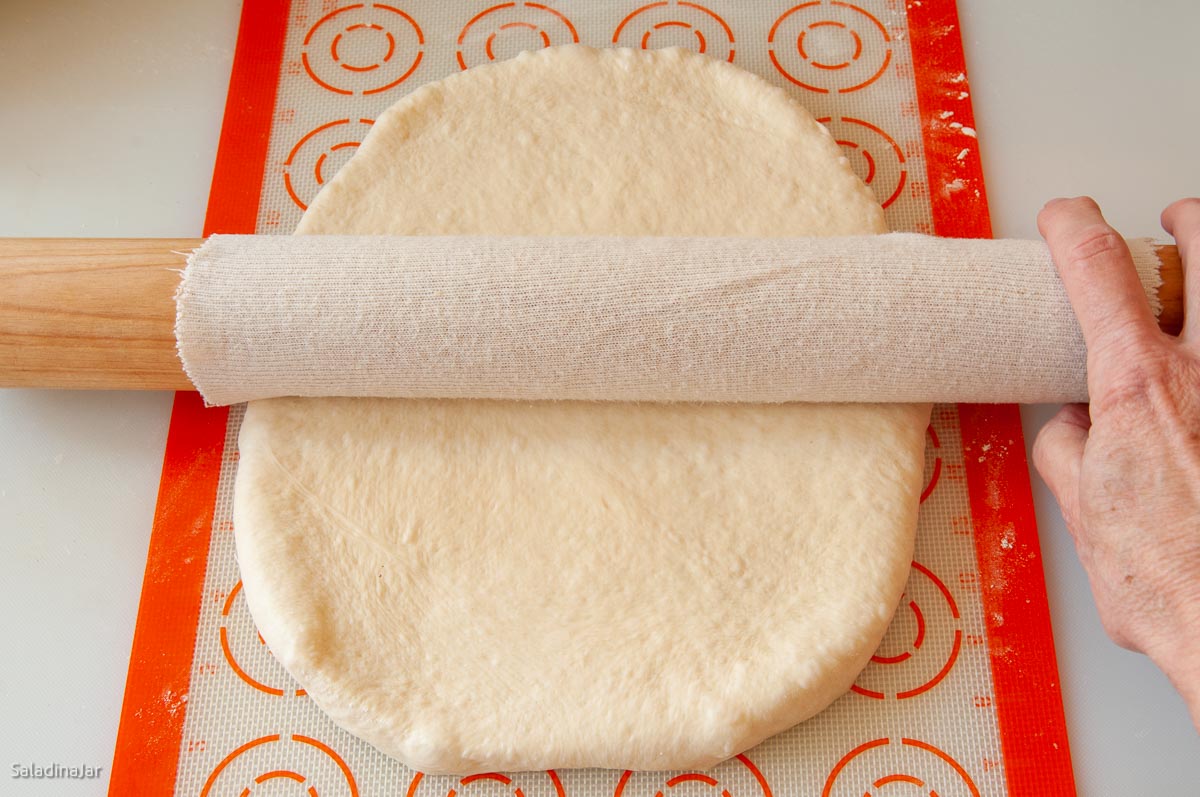

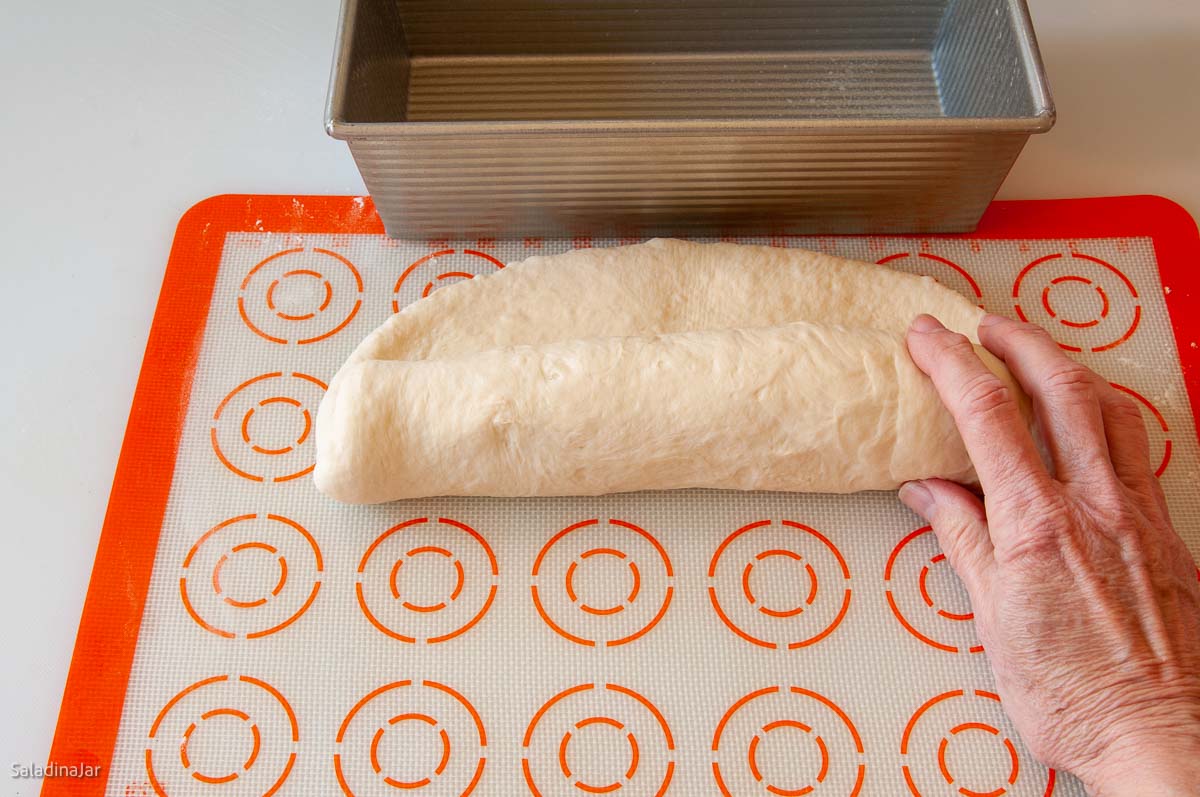

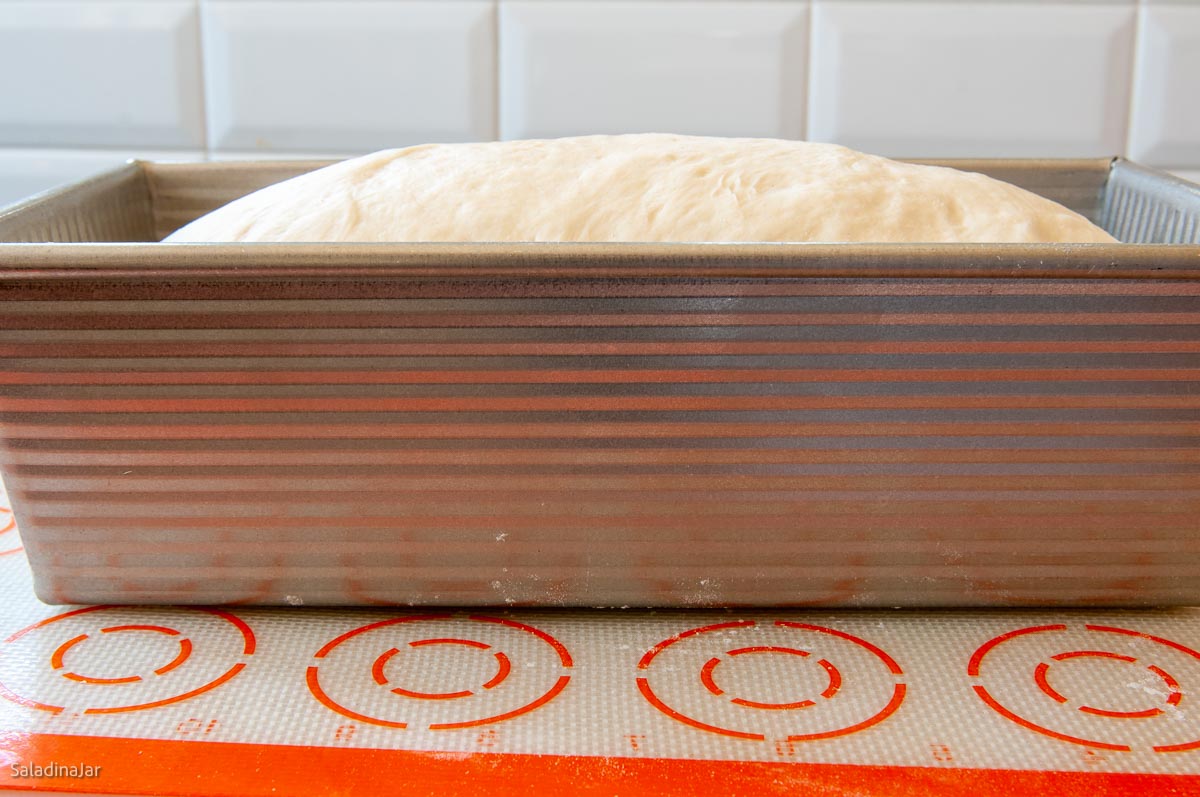
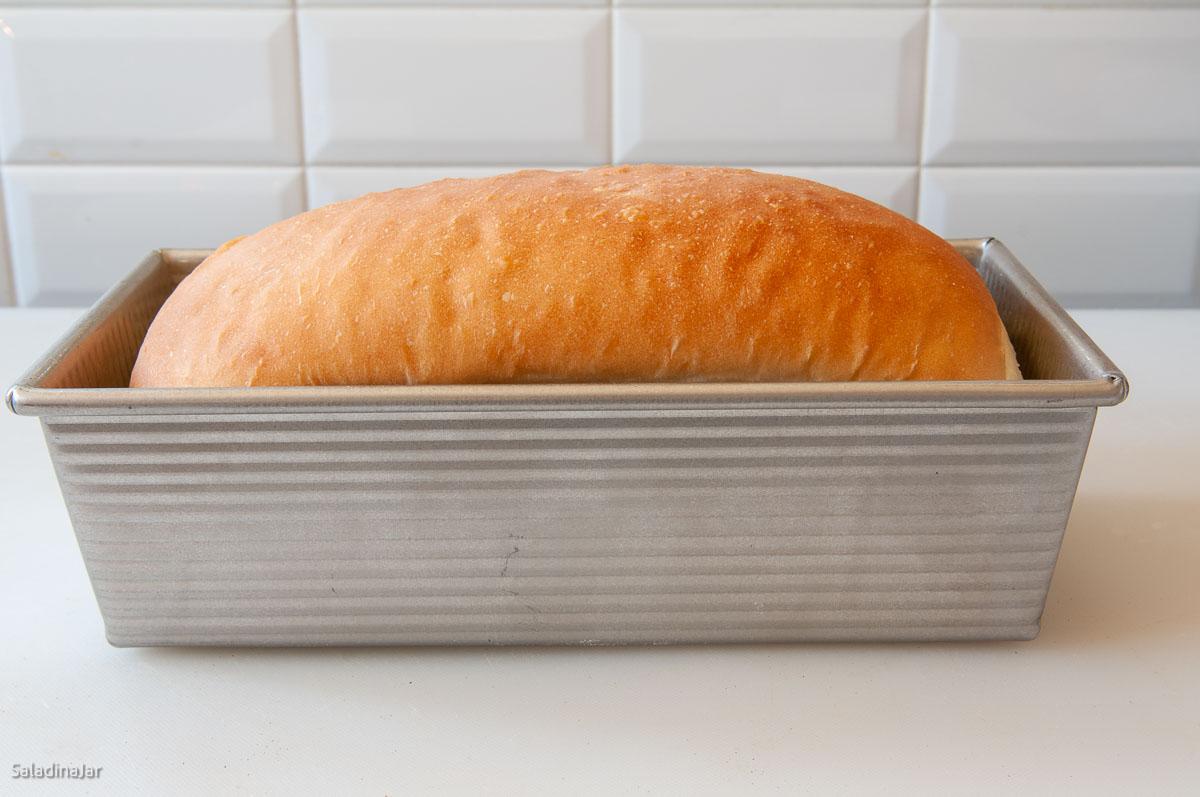
If you prefer sweeter and richer white bread, be sure to take a look at my Condensed Milk Bread: A Not-to-be-Missed Bread Machine Recipe and this Buttermilk Bread Machine Bread Recipe.
FAQs About Using a Bread Machine To Make a Basic White Loaf
Whole-grain flour has its own set of rules. If you’re new to bread baking, it’s best to follow the recipe as is.
Experienced bakers can start by substituting half a cup of whole wheat flour for half a cup of bread flour. If that works well, gradually increase the amount.
Remember, the more whole-grain flour you use, the denser your bread will be, and the smaller the loaf may turn out. Also, keep an eye on your dough as it kneads to make any necessary adjustments to its consistency.
If your bread machine has a PREHEAT cycle and you can turn it off, do so, especially since you’re not using the machine to bake the bread.
If you can’t turn off the PREHEAT cycle, let it run its course before the DOUGH cycle starts. Alternatively, start the PREHEAT cycle as soon as you enter the kitchen. By the time you’ve gathered and measured your ingredients, the DOUGH cycle should be ready to begin.
If your bread machine offers multiple DOUGH cycles, always select the regular DOUGH cycle for my recipes. A longer rising time improves the flavor of the bread. Remember, good bread takes time to develop its best taste.
Yes. You can. The first loaf pictured below was baked in a bread maker. Lower your expectations. The crust might turn out thicker and crunchier. The top may not be rounded and pretty. But hopefully, the bread will be good enough for toast. Don’t forget to open the lid and check the dough to adjust it on the fly. Hopefully, your bread won’t turn out too dense or with a crater on top due to environmental extremes or sloppy measuring techniques.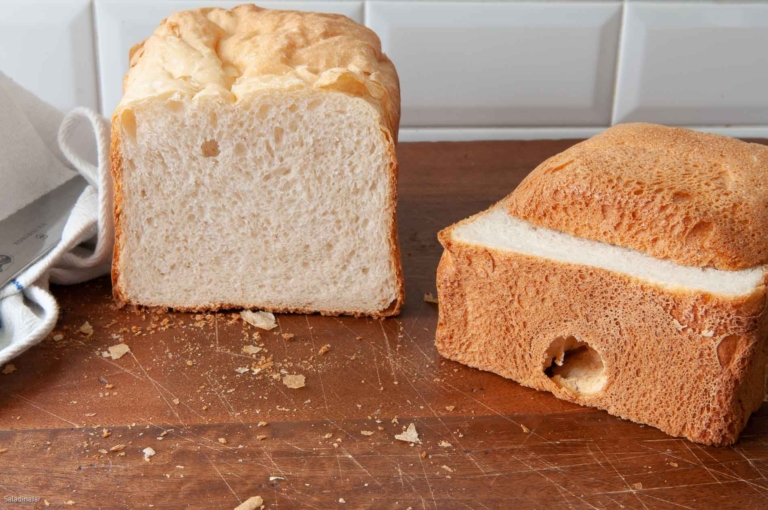
Since this recipe calls for 3 cups of flour and is a high-riser, I suggest you use a 9×5-inch loaf pan or a 9x4x4-inch Pullman pan (paid link). If you have a dark pan, use that one for a darker crust color.
In my experience, when the sides and bottom of the loaf are darker, they are also stronger. Since this is a light and fluffy loaf, the sturdier sides help support the bread, especially when slicing it.
In the picture below, the bread on the left was baked in a shiny pan. The bread on the right was baked in a black pan. Everything else was the same.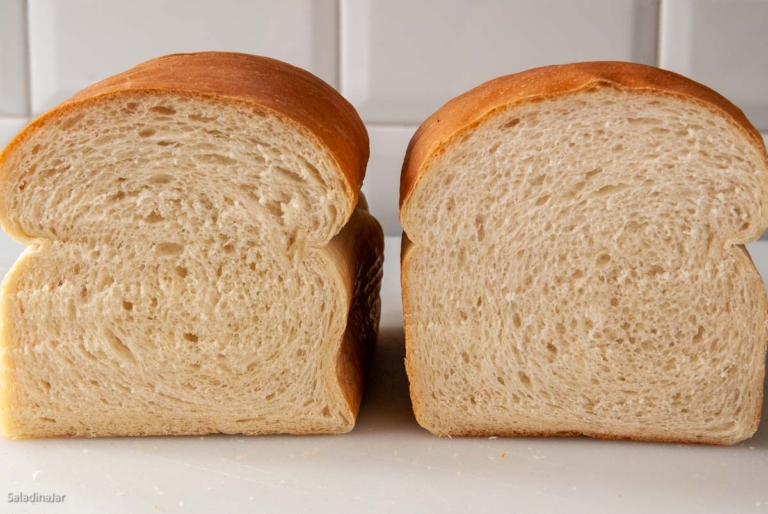
If your bread overflowed or blew out on one side, the pan was probably too small. It’s important never to fill a pan more than halfway with dough. This recipe produces a high-rising bread, so using the specified pan size is crucial. If your pan is smaller, don’t use all the dough in it. You can use the excess dough to make rolls or a smaller loaf.
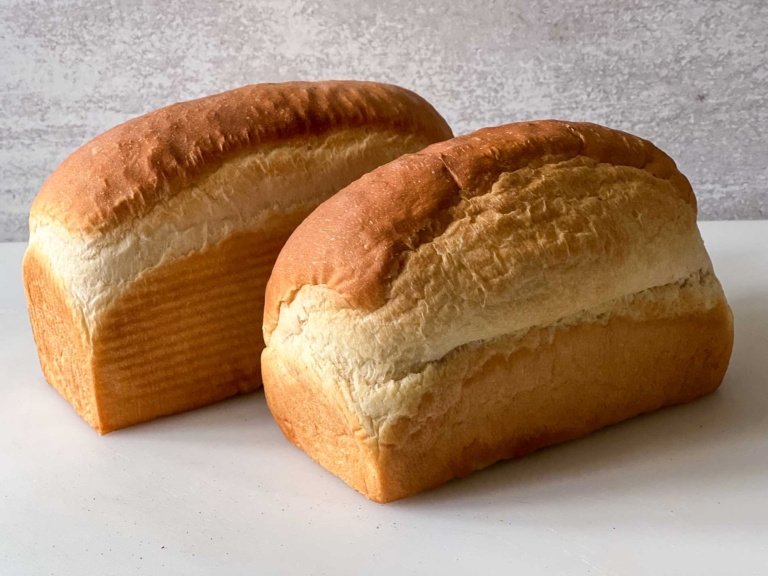
The dough was too dry. Weigh the flour when adding it to the dough if at all possible. Most people add too much flour when they use measuring cups.
Another reason for crumbly bread is poor shaping. Shaping structures the gluten so it looks better and holds the crumb together. The latter is especially important with sandwich bread.
Be sure your bread is completely cooled. Place in a plastic bag unsliced, or store in a bread box. You can pre-slice the bread for convenience, but I find the bread dries out faster when sliced.
You can also freeze this bread. Double-wrap it (plastic wrap, aluminum foil, or plastic bags) and try to eat it within one month for the best flavor. Avoid refrigeration since the humidity will cause the bread to go stale faster and eventually mold.
Parting thoughts: If you prefer a sturdy and chewy loaf, look at my Sourdough Sandwich Loaf or Bread Machine Oatmeal Bread. If you prefer whole wheat bread, try my Honey Wheat Bread Machine Recipe or this Wheat Berry Bread.
If You Are a Bread-Baking Beginner, These Posts Might Help
- 6+ Bread Maker Tips You Need To Make Marvelous Bread
- The Surprising Secret to Making Better Bread with a Bread Machine
- Why Is My Bread So Dense? (Bread Machine Section Included)
Recipe Help at Your Fingertips: For questions or suggestions, email Paula at saladinajar.com. If you need help, I’m happy to troubleshoot via email (faster than leaving a comment). Attach pictures and as many details as possible for the best advice.
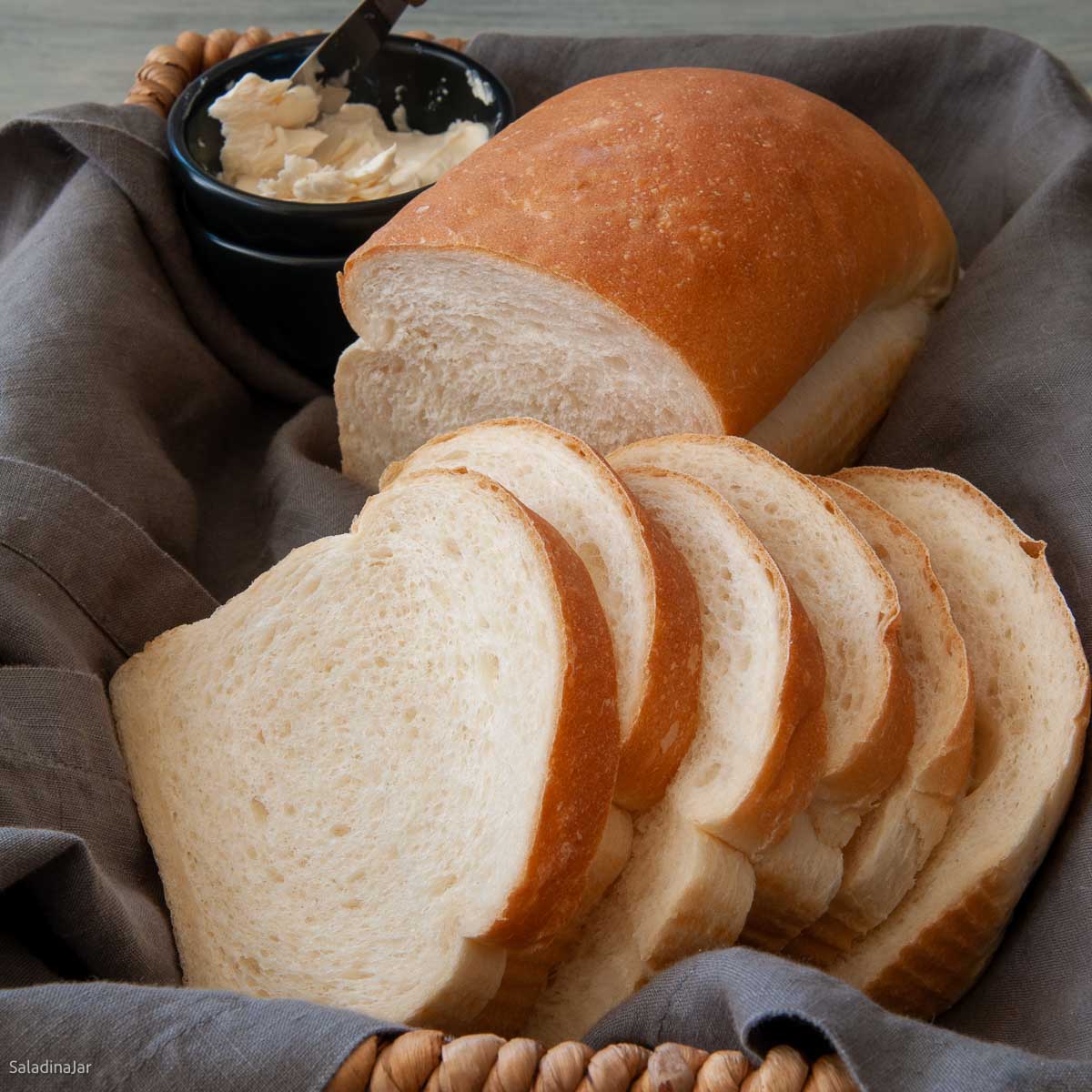
Basic White Bread Machine Recipe
Rate this recipe
(5 stars if you loved it)
Video
Ingredients
- 1 cup (227 g) water cool
- 1 tablespoon sugar granulated
- 1¼ teaspoon table or sea salt
- ¼ cup (21 g) nonfat dry milk powdered
- 1 tablespoon butter chopped
- 1 teaspoon lemon juice
- 3 cups (360 g) bread flour
- 1½ teaspoon instant or bread machine yeast
Instructions
Making the dough:
- Add 1 cup (227 g) water, 1 tablespoon sugar, 1¼ teaspoon table or sea salt, ¼ cup (21 g) nonfat dry milk, 1 tablespoon butter, 1 teaspoon lemon juice, 3 cups (360 g) bread flour, and 1½ teaspoon instant or bread machine yeast, to the bread machine pan. Select the DOUGH cycle and press START.
- Check the dough at least twice during the mixing and kneading phase by lifting the lid to take a peek. The first time, look immediately after the machine starts mixing to ensure the paddles are engaged correctly. Look again 15 minutes into the DOUGH cycle to assess the consistency of the dough. For most recipes, the dough should stick to the side, then pull away cleanly.If your dough is too wet, add flour one tablespoon at a time.Conversely, if the dough is too dry, add one tablespoon of liquid at a time until the dough looks just right. Read more about this surprising secret to success with a bread machine here.
- It’s important to check the dough at least twice during the mixing and kneading phase. First, lift the lid right after the machine starts mixing to ensure the paddles are working properly. Then, check again about 15 minutes into the DOUGH cycle to assess the dough’s consistency. Ideally, the dough should stick to the side and then pull away cleanly. If the dough is too wet, gradually add flour, one tablespoon at a time. If the dough doesn’t stick at all, add water, one tablespoon at a time.
Shaping the dough:
- Take the dough out of the pan and place it on a lightly floured surface. Use your palms to push down on the dough to remove any air bubbles. Shape it into a smooth ball, cover it, and let it rest for 15 minutes.
- Roll the dough out into a rectangle, aiming for dimensions of about 10 x 13 inches. Use a rolling pin to gently press down any large bubbles, especially around the edges, to improve the bread’s texture and prevent unwanted holes.
- Start rolling the dough from a short side, or from a long side if you’re using a Pullman pan. Roll it snugly without stretching the dough. Use your fingers to pinch the seam closed. Then, pull up each end towards the seam and pinch those shut as well. Refer to the process pictures in the post for guidance.
- Turn the dough cylinder over so the seam is on the bottom and gently place it into a greased loaf pan. This recipe is suitable for either a 9×5-inch or an 8½x4½-inch loaf pan. Each size will yield a slightly different loaf shape.
- Cover the dough with a towel and let it rise one last time before baking. This rise can take from 45 minutes to over an hour. Focus on the dough’s progress rather than the clock. Start preheating the oven to 350 °F (180˚C) roughly 15 minutes before you expect the bread to be ready for baking.
- When the bread has nearly doubled in size, bake it in the middle of the oven for 25-30 minutes. The internal temperature of the bread should reach between 195-200 °F (90-93˚C) for it to be properly baked.
- After baking, take the bread out of the oven and let it sit in the pan for 15 minutes. Then, transfer it to a cooling rack and let it cool for at least 30 minutes, ideally an hour, before slicing.
Notes
- To make this recipe using a heavy-duty stand mixer: Add the ingredients to the mixer bowl in the same order as listed. Start on LOW speed to mix until all ingredients are moistened. Then, switch to using a dough hook and increase the speed to 2 or 3. Continue beating/kneading until the dough becomes smooth and elastic, which should take about 5-10 minutes. Cover the dough and let it rise in a warm place. Once risen, gently deflate the dough and shape it as directed in the recipe.
- If making the dough by hand, mix all ingredients in a large bowl to form a shaggy ball. Turn the dough out onto a floured surface and knead by hand until it becomes smooth and elastic. Kneading might take 10-20 minutes, varying with your experience. Place the kneaded dough in a greased bowl, cover it, and let it rise until it doubles in size. After rising, gently deflate the dough and shape it as the recipe directs. Note about the yeast:
- If using active dry yeast instead of instant yeast, add an extra 1/4 teaspoon to the recipe. Although it’s not necessary to dissolve active dry yeast in water anymore, you may do so if you prefer.
- If your bread is taking too long to proof during the final rise, consider adding an additional 1/4 to 1/2 teaspoon of yeast or find a warmer spot for the dough to prove. While using less yeast and allowing for a longer rise can enhance flavor, it may not always be practical. Adjust according to your convenience and needs.
Equipment
Nutrition
All images and text ©️ Paula Rhodes for Salad in a Jar.com

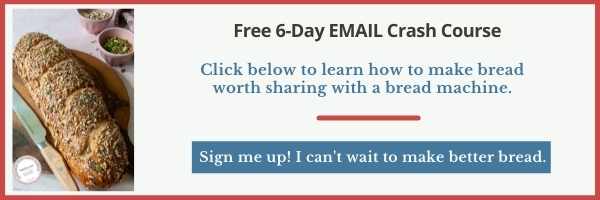

Paula Rhodes, owner
As a retired home economist, I created Saladinajar.com to share my belief that you don’t have to be a chef to find joy in creating homemade food worth sharing. Bread machines (used in an unconventional way), homemade yogurt, and quick microwave recipes are my specialty.